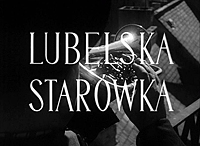 Lubelska starówka
Lubelska starówka
Poland, 1956, black and white, 5 mins
One characteristic of the ‘black series’ that became increasingly apparent in 1956 was the use of sarcasm, though it was rarely deployed quite as overtly as this. In many ways a sequel to-cum-parody of the likes of Return to the Old Town (Powrót na Stare Miasto, 1954), the film begins with an aerial pan around the ancient medieval city of Lublin while the commentary extols its virtues as though it was another Nowa Huta (a purpose-built workers’ paradise depicted in the entirely straight-faced Destination Nowa Huta!/Kierunek – Nowa Huta!, 1951), an immaculate example of architecture and visionary planning that represents the best that Poland has to offer.
After two minutes of this drivel (accompanied by various cheesy shots of tourists admiring the buildings while dressed to the nines in what one presumes was the height of 1956 fashion), one might be under the impression that director Bohdan Kosiński had shot the film two or three years earlier and had delayed its release for some unknown reason (certainly not government censorship: this was just the kind of vacuous puffery that the authorities loved). But then the film’s true satirical purpose reveals itself as we get a glimpse behind Lublin’s ornate façades, and discover that they’re very similar to what lurked in Warsaw’s side streets – as depicted in such films as Brzozowa Street (Ulica Brzozowa, 1947) and Warsaw ’56 (Warszawa 1956).

But although his message is broadly similar, Kosiński eschews lyricism or sensationalism in favour of full-on sarcasm. Over shots of children playing in a courtyard that doubles as a rubbish tip, we’re told about the level of care taken “to preserve the authentic character of these historical spots”. A perilous crack in a wooden balcony is “an original fracture from the times of Biernat of Lublin”, while a rickety ladder missing half its steps “has an invigorating effect, contrasting with boring and conventional stairwells”. And it continues in a similar vein – crumbling walls of near-derelict buildings are “our own counterpart of the Forum Romanum”, a visibly rotting water pipe has a “medieval ascetic ambience, facilitating the renunciation of the illusion of worldly comforts”, while wooden pillars blatantly and somewhat desperately propping up the ceilings are “stylish ornaments”.
Very funny though this is, there’s an underlying anger that establishes it as an authentic work of satire in the same lacquer-black vein as Jonathan Swift’s A Modest Proposal. The film is unsparing in its presentation of the appalling living conditions of Lublin’s disadvantaged, and the commentary’s attempt at glossing over the evidence in front of us performs a double duty as a scathing critique of the officially-sanctioned lies and blind-eye-turning of the Socialist Realist period, as well as an implicit attack on the town authorities whose commitment to renovation ceased once all the areas with any appeal to tourism had been given a lick of paint.

Throughout, we hear the sound of a solo trumpet. As in Little Town (Miasteczko, 1956), the music essentially consists of the same tune in the same style throughout, but by the end of the film the initial impression – in this case one of stately grandeur – has been not so much undermined as completely demolished.
This was Kosiński’s first film, made while he was still studying at the Łódź Film School – he would go on to become one of the most distinguished and prolific Polish documentary makers.
- Director: Bohdan Kosiński
- Camera: Leszek Krzyżański
- Production Company: State Theatrical and Film College (PWSTiF) in Łódź, WFD
The film is included on PWA’s Polish School of the Documentary: The Black Series double-DVD set (Region 0 PAL). Perhaps because of its film-school origins, the print isn’t in quite as good a condition as with many of the other films on these discs, though its original satirical purpose comes through loud and clear. Regrettably, the subtitles have several typos (more than average for this release), and while it’s always obvious what they mean, they don’t go especially well with a spoken commentary that clearly prides itself on its linguistic precision.